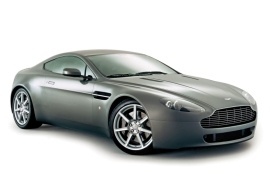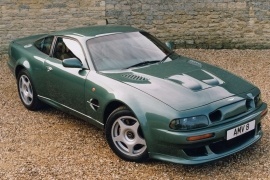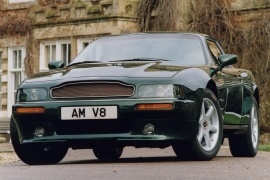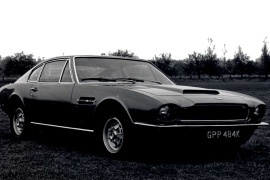
ASTON MARTIN V8 Vantage
Generations Timeline, Specs and Pictures

A game-changing new Aston Martin Vantage was introduced for 2018, polarizing people with its striking new design.
One of the biggest departures from the classic Aston Martin lines can be seen up front, where the grille now goes further down to meet the air splitter, and also has a border to it that kinda sticks out on the sides. The design story continues inside the Vantage, with a dynamic and focused sports car cockpit that rejects long, fluid curves in favour of sharp, focused lines denoting the more aggressive nature of the car. A high waist interior theme and lower driving position creates a more immersive driving experience, and contributes to significant gains in occupant space and significant improvement in headroom compared with the outgoing Vantage. The heart of the Vantage is Aston Martin’s potent new alloy, 4-liter twin-turbo V8 engine which sits low and as far back in the chassis as possible for optimal center-of-gravity and perfect 50:50 weight distribution. A great new addition is the first Electronic Rear Differential in the Aston Martin range.

Aston Martin introduced in 2008 a facelift that affected both the V8 Vantage Coupe and V8 Vantage Roadster (Volante).
This consisted mainly of technical modifications, but featured also some minor design changes, with the interior receiving a DB9 and DBS inspired center console. The technical updates included a new 4.7L V8 petrol engine that replaces the old 4.3L V8, updated transmission and suspension. Aston Martin opted for a stiffer suspension with Bilstein dampers. Power and torque were both increased by 11% and 15% respectively, while fuel consumption and CO2 emissions were reduced by 13%.

Inspired by Aston Martin’s rich racing pedigree, the new N430 is the most dramatic expression of the V8 Vantage ever made so far.
Building on the legacy of the acclaimed N400 and N420 special editions, V8 Vantage N430 delivers excitement and intense performance with a thrilling club sport ethos. Inspired by GT4 racecars, the N403 can be had in multiple colors with contrasting grille surround, mirror casings, rear diffuser blade and roofline. Under the nicely shaped body lies a stiff aluminum core to keep the weight down along with a magnificent 4.7-liter V8 mated to a six-speed gearbox. Inside, as out, N430’s sporting associations are unmistakable with new interior features and materials such as machined carbon sill plaques, N430 seat logos, black magnesium paddle-shifts or carbon fibre gearshift surround; contemporary driver instrument panel; black anodised rotaries; leather steering wheel with contrasting on-centre stitch feature (or Alcantara with matching stitch); seat and door inserts in technical PlissèAlcantara - indented leather on Roadster models - and unique seat trim patterns.

Limited to 200 units produced, the 2019 Aston Martin Vantage AMR was launched just a day before the penultimate round of the FIA Endurance Championship, the birthplace of the Vantage AMR.
Aston Martin had a long motorsport history before launching the Vantage AMR. It wasn’t the only AMR ever built by the British car manufacturer. Previously, it built the four-door Rapide and the previous Vantage in 2017, and also the DB11. Unlike those, the 2019 Vantage AMR was available exclusively with a 4.0-liter twin-turbo V8 engine provided by Mercedes-AMG mated to a 7-speed manual gearbox.
On the outside, the look was enhanced with the addition of carbon fiber, which could be found on the front spoiler, the side exhaust vents on the front fenders, and the side sills. A carbon-fiber roof and mirror cases were noticeable, and, in the rear, a newly designed bumper that integrated the rear diffuser was also made out of carbon-fiber completing the overall look. A quad exhaust was present, instead of the regular, dual type.
Inside, the carbon-fiber fever was noticed on more elements from the dashboard to the center console. Apart from that, the interior was enhanced with the extensive use of the Alcantara. But the designers could have used an aluminum gear-lever knob instead of a plastic one. The AMR didn’t forget about modern technologies such as an infotainment unit, or air-conditioning.
By using a manual transmission, a mechanical differential, and the extensive use of the carbon-fiber, the Vantage AMR saved about 200 kg (440 lbs) of weight. It also lightens up the braking system by using carbon ceramic brakes a lighter, 20” wheels. To help the drivers with the manual transmission, the AMR does the rev-match with up-shifting and downshifting.

In 2006, in a daring quest, a road-registered Aston Martin V8 Vantage entered the 24h of Nurburgring race.
It was a slightly modified version of a street-legal vehicle. It didn’t win but it finished in fourth place in its class and 24th overall.
The result was even more important since it wasn’t driven by professional racing drivers. There were company employees, including the Aston Martin CEO, Dr. Ulrich Bez. The result was good enough to make the brand repeat the stunt in the following years with other different vehicles, including the four-door Rapide.
The Vantage N420 was a car designed to remember the big success achieved by the team in 2006. It was based on a standard Aston Martin Vantage. The standard Vantage offered 420 hp, the same as the special edition. But the N420 featured some carbon-fiber elements that helped decrease the total weight by 27 kg (60 lbs). In the back, the car featured a diffuser to help reduce the drag and increase the cornering speed.
Inside, there were options for street, comfortable yet bolstered seats, or carbon-fiber seats. The car featured standard Bluetooth connectivity and parking sensors. On the door sills, there was a carbon-fiber decal with the Vantage N420 logo on it.
For the color scheme, the N420 was available with a two-tone livery, to celebrate various racing Astons. Some of them were more inspired than others.
The car featured the “sports-pack” stiffer suspension, offered as an option for the regular V8 Vantage. The transmission was a six-speed with paddle-shifters behind the steering wheel.

In 2005, Aston Martin was still linked with Jaguar and Ford.
But it was still a luxurious GT car that featured a different approach to its customers and a different market.
The 2005 Geneva Motor Show was the place where Aston Martin decided to unveil its latest creation, the V8 Vantage. Even if it shared some components with some vehicles from Ford, its overall look was different and it gathered the attention from the deep-pockets buyers.
The 2005 Aston Martin V8 Vantage was based on its own developed platform, named VH from the second generation. The car featured a twin grille design, with the upper side in the traditional Aston Martin shape and a wide one on the lower part of the bumper. The headlights featured the daytime running lights on the inside, with a twin bulb design for the low and high-beams. Two air-vents were noticeable on the hood, closer to the windshield. The rear design showed the muscular arches of the quarter panels. The two, round exhausts were going through the lower side of the bumper. The horizontal V-shaped taillights were a specific styling element of the car.
Inside, the luxurious GT offered leather-covered sport-bucket seats. The dashboard used the same unusual tachometer that went counter-clockwise. But, with some buttons carried over from some Ford models.
Under the hood, there was a 4.3-liter engine hand-built in Cologne-Germany by Aston Martin engineers. It featured a dry-sump lubrication system so the engine would support hard driving conditions. It was tested for 12.000 miles in Dubai. A 6-speed automatic gearbox was offered from the launch and it was mounted in the rear, in a transaxle system.

The last 40 units of the Aston Martin V8 Vantage received an extra ‘Le Mans’ designation in honor of company’s Aston DBR1 incredible victory of the 24 Hours of Le Mans in 1959.
Aston Martin prepared a special engine for this late edition of the V8 Vantage, updating its 5.3L unit to 600 hp (that’s why it was also called V600). The car also featured a redesigned grille (’70s-style), new side vents and nostrils. Despite being fitted with plenty of luxury features, the V8 Vantage Le Mans was one of the fastest models in company’s history, doing the 0-60 mph in 4 seconds and reaching a top speed of 322 hm/h.

The Aston Martin V8 Coupe was the entry-version of the V8 Vantage model and was produced from 1996 to 2000.
Featuring a more conservative look than its Virage/Vantage ‘brothers’, the V8 Coupe was fitted with a 5.3L V8 supercharged engine delivering 350 hp and 369 lb-ft of torque. The new car lacked V8 Vantage’s bonnet vents but featured mesh radiator grille and air intakes in the front spoiler. The Aston Martin V8 Coupe was produced in 101 units throughout its 4 years of existence and was only available for the European and Middle East markets (didn’t make the US due to approval reasons).

Aston Martin produced the V8 Vantage based on the Virage model starting 1993.
The new car featured a wider wheelbase and was fitted with a 5.3L twin-supercharged engine delivering up to 550 hp and producing 550 lb-ft of torque. Despite its 2-ton GVW rating, the V8 Vantage would reach 0-60 mph in 4.6 seconds and have a top speed of 186 mph. Some of the most interesting exterior updates presented with the new V8 Vantage were the ‘grapefruit-like’ taillights and the lower ground clearance. Its engine was later updated to 600 hp for the special edition Le Mans V600, while the actual V8 Vantage (Virage-based) model would be discontinued in 1998.

It was one of the most famous Aston Martin in the ’80s after it starred in the James Bond franchise movie “The living daylights” and it was a supercar of its era, even if Aston Martin considered it as a GT.
While the world recovered from the oil crisis, the British car-company Aston Martin needed a new generation for the luxury coupe and convertible market. But with the bigger engine from the Lagonda under the hood, the new model was named Vantage. It was the original Vantage.
From the outside, the British Grand Tourer featured a low height, a long hood with a bulge in the middle, that differentiated it from the other Aston Martin V8 (Series 3) model. In the front, it featured two round headlights and two fog-lights installed in the grille. The fastback shape and the proportions of the car gave it a nickname of a British Muscle-car.
Inside, it was a marriage between wood and leather, with chromed metal parts as rings of engagement on the instrument cluster. The 2+2 seating was more like a 2-seat cabin. The low driving position and the floor-mounted gears-stick were part of the car’s charm.
Under the hood, there was a 5.3-liter engine that offered 394 hp when it was introduced. Over the years, the engine was upgraded up to 403 hp after 1986. The early models featured a 5-speed manual, while the later ones received a 6-speed manual.

Aston Martin V8 - also called the Series 2 - entered the production line in 1972.
After only one year, this two-door successor of the DBS V8 model was fitted with a 5.3L unit - and four twin-choke carburettors - producing 315 hp and reaching the 0-60 mph line in 5.7 to 6.1 seconds (depending on the transmission). In terms of exterior look, the Series 3 featured a redesigned hood (scoop-style, to accommodate the carbs) and a mesh grille. The Aston Martin V8 was produced in 967 units until the discontinuance of its Series 3 model in 1978. The Series 3 was replaced by the Series 4 Oscar India model (1978 to 1985) and finally the Series 5 V8 (1986 to 1989).























































